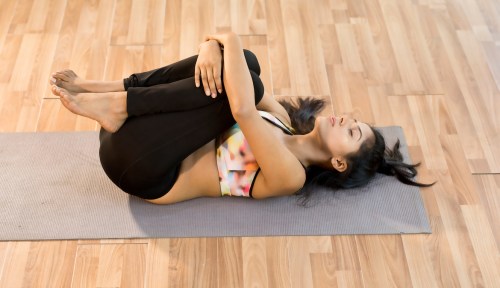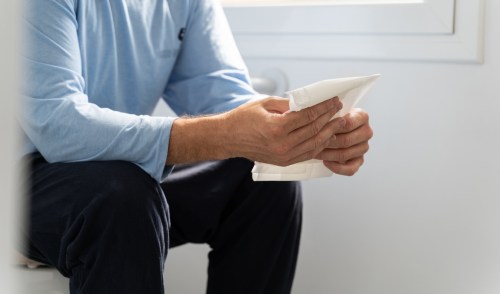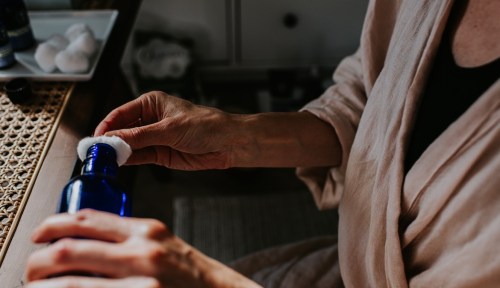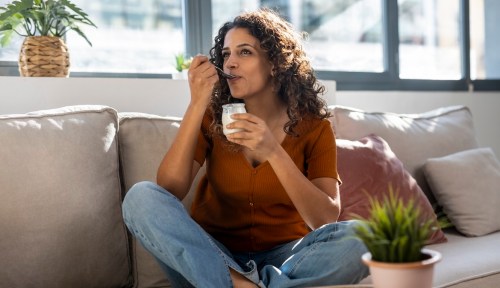‘I’m a Yoga Teacher and Acupuncturist, and These Are the 3 Moves I Do Whenever I’m Having Digestion Issues’
A yoga instructor and acupuncturist shares how she uses yoga for digestion by combining poses with acupressure points.

Yoga can help with so many aspects of our physical, mental, and spiritual well-being. And that includes our digestion. The practice of yoga can reduce stress, which helps regulate the gut-brain axis. There’s even recent research that suggests yoga may be a remedial treatment for IBS.
Experts in This Article
And around the holiday season, when wellness-minded folks indulge at various celebrations and then look for a yogic antidote, it’s common to see bloat-relieving poses making their way into circulation. But poses are only one of the eight limbs of yoga. To truly embrace the practice, honor its roots, and feel its effects, we need to approach yoga holistically, bringing proper concentration and breath, for instance, to any flow.
Yoga instructor Sara Sas,RYT, L.Ac., adds acupressure to this, too. Also a licensed acupuncturist and Traditional Chinese Medicine practitioner, she recently shared with Well+Good that, when she’s dealing with digestive issues, she pairs certain yoga poses with acupressure (i.e., no needles!). This gives her an added boost of relief and digestive support. Here, she shares her three go-tos.
1. Wind-Relieving Pose (Pawanmuktasana)
- 1.Laying on your back, inhale and extend both of your legs out straight. On an exhale, hug your knees into your chest using both arms, connecting the tops of your thighs to your stomach/chest.
- 2.Take a few deep breaths in this position, allowing your body to relax and release.
- 3.Find your acupressure point (details below) and massage that for a minute or so as you hold this pose, continuing to breathe deeply and mindfully.
Acupressure point: Stomach 36
Find it: Place your hand just below your opposite knee, with the side of your index finger along the base of your kneecap. At about the tip of your pinky, just on the outside of your tibia, you’ll find this digestion-supporting acupressure point.
Why this works:
“On its own, Pawanmuktasana is a go-to pose for gas and bloating relief, as it helps to expel trapped air in the digestive tract,” says Sas. “Combining this with acupressure at the command point of the abdomen, according to Traditional Chinese Medicine, benefits the stomach and spleen by helping with the nourishment of digestion, while regulating intestines and expelling wind-gas. It’s a win-win.”
2. Goddess Pose (Utkata Konasana)
- 1.With your feet wider than hips-width distance apart, turn your toes outward. (Think: sumo squat or second position grand plié)
- 2.Sink into a squat, tucking your tailbone slightly, maintaining an external rotation with your thighs. Lock in your abdominal muscles and maintain an upright spine with relaxed shoulder blades.
- 3.Lift your heels up, putting the weight into the balls of your feet.
- 4.Lower heels, shifting weight into the back of the feet to lift the toes.
- 5.Hinge at the waist to grab under your toes and stimulate the pressure points (see below to locate). You can do this one at a time.
- 6.Repeat the lifting and lowering of your heels, focusing your attention on the acupressure point.
- 7.End with feet flat on the ground.
Acupressure point: Kidney 1
Find it: “This point is basically the center of the sole of the foot,” says Sas. (Think more bottom of your metatarsals, rather than bottom of your arch.)
Why this works:
“Goddess pose helps generate warmth throughout your body, and the increased circulation can help with your digestion,” says Sas. Adding the Kidney 1 acupressure massage can help center you. “Breathe deep, sending energy into your feet to feel a sense of grounding, support, and strength,” says Sas. “When we are grounded and centered, our digestion is supported.” The opposite is also true: When we’re stressed, our digestion takes a toll.
3. Easy Seated Twist (Parivrtta Sukhasana)
- 1.Sitting in a cross-legged position, with your spine straight and the crown of your head reaching toward the sky, bring your left hand to your right knee.
- 2.Keeping your spine straight, twist to the right, placing your right hand behind you on the floor, near your hip. Ensure you don’t go too far and lose your posture.
- 3.Look over your right shoulder, and breathe deeply into the twist.
- 4.In this position, locate and massage the acupuncture point with your left hand (location detailed below).
- 5.Change your cross-legged position (if the right leg was on top, bring the left to the top) and repeat this exercise on the opposite side, ensuring you continue to breathe deeply.
Acupressure point: Spleen 21
Find it: “This point is called ‘The Great Embrace’ and is located on the side of your ribcage,” says Sas. “It can be easily stimulated during a seated spinal twist while you give yourself a hug.”
Why this works:
Twisting poses are popular choices for digestive health, and for good reason: Twisting the torso helps stimulate the digestive organs.
With easy seated twist, especially when you begin with a twist to the right, you’ll massage the ascending colon, and then descending colon as you twist to the left, helping to “move things along,” as they say. Adding in some acupressure bolsters this effect. “Spleen 21 moves Qi [energy] and blood,” explains Sas. “This transforms stagnation in the body, especially around the diaphragm, which [according to TCM] assists with better digestion.”
—reviewed by Jennifer Logan, MD, MPH
Sign Up for Our Daily Newsletter
Get all the latest in wellness, trends, food, fitness, beauty, and more delivered right to your inbox.
Got it, you've been added to our email list.










